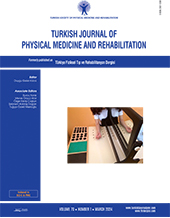The efficiency of mirror therapy in peripheral nerve injuries
2 Department of Physical Medicine and Rehabilitation, Medicine Faculty of Kocaeli University, Kocaeli, Türkiye
3 Department of Occupational Therapy, Kocaeli University School of Vocational Health Services, Kocaeli, Türkiye
4 Department of Physical Therapy and Rehabilitation, Körfez State Hospital, Kocaeli, Türkiye
5 Department of Orthopaedics, Traumatology and Hand Surgery, Private Derindere Hospital, Istanbul, Türkiye DOI : 10.5606/tftrd.2024.12648 Objectives: The purpose of this study was to investigate the effectiveness of mirror therapy on pain, sensory, and functional development in addition to conventional rehabilitation and occupational practices in patients with a peripheral nerve injury in the hand.
Patients and methods: Twenty-six patients with peripheral nerve injury in the hand were included in this randomized controlled study between November 2017 and May 2018. The patients were randomly assigned to the mirror group (n=14) and the control (n=12) group. Both groups received conventional therapy in our clinic for 45 min a day during weekdays for six consecutive weeks. The mirror group received an additional 10-15 min of visual mirror therapy. Visual Analog Scale (VAS), Duruöz Hand Index, Quick Disabilities of the Arm, Shoulder, and Hand, Jebsen hand function test, and Semmes-Weinstein monofilament test were used for the assessment of pain, hand function, and sensation of the patients at baseline and after treatment. The handgrip strength of the patients was measured with a dynamometer.
Results: A total of 20 patients (17 males, 3 females; mean age 31.9±16.5, range 16 to 65 years) completed the study, with 10 in each group. Statistically significant improvement was detected in hand skill functions, such as page-turning (p=0.004), backgammon packing (p=0.023), and heavy object lifting (p=0.029) in the mirror group. A statistically significant decrease was found in total scores of VAS after treatment in both groups (p<0.05).
Conclusion: The results imply that mirror therapy integrated with conventional rehabilitation may aid additional benefits on hand functions in peripheral nerve injury. These results demonstrate that mirror therapy can be used in addition to the rehabilitation program of patients with peripheral nerve injury.
Keywords : Hand rehabilitation, mirror therapy, occupational therapy, peripheral nerve injury
















